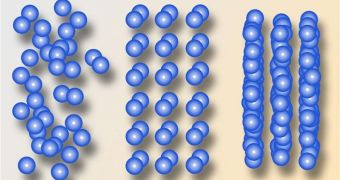While conducting a study to determine the behavior of tiny particles called colloids inside liquids, researchers at the Vienna University of Technology (TU Vienna) and the University of Vienna (UV) found that the particles were spontaneously producing organized structures when subjected to stress.
According to the researchers, the particle clusters arranged themselves into strings, or other types of organized structures, which together contributed to drastically altering the fundamental properties of the liquid in which they were flowing.
Colloids can be found in liquids as different as blood, ink and gruel, but their effect is the same overall. When they exist suspended in liquid, colloids tend to form clusters naturally. Each of these clusters can then go one to set the basis of a larger structures, which forms by the addition of extra clusters.
After the arrangement is concluded, the structures look just like atoms in a crystal. Using computer simulations, the Austrian researchers were able to analyze these crystal-like substances in great detail.
One of the most interesting conclusions the group arrived at was that mechanical stress plays a significant influence in determining the behavior of self-arranging colloids. Researchers say that this discovery could have important implications for the field of materials science.
Details of the new work appear in the latest issue of the respected scientific journal Physical Review Letters, AlphaGallileo reports. Interestingly, the experts discovered that the structures the clusters assemble into maintain a steady distance from each other.
“Increasing the density of particles adds more and more particles to each cluster – but the distance between them stays the same,” explains study researcher Arash Nikoubashman, who holds an appointment as a PhD student at TU Vienna.
The expert is also responsible for devising the calculations that enable the new study, together with TU Vienna Institute for Theoretical Physics professor Gerhard Kahl. The team was completed by UV professor Christos Likos.
“Previous results had already led us to believe that these particles could exhibit strange behavior under certain external conditions,” the research team explains. Experts say that the new findings could enable new technologies, such as vibration dampers and protective clothing.
The end goal is to be able to produce a liquid that changes its physical properties upon impact. For example, one can envision creating clothes that protect pedestrians if they are hit by a car, and similar applications.

 14 DAY TRIAL //
14 DAY TRIAL //